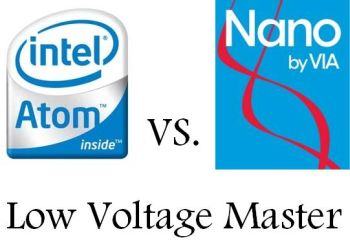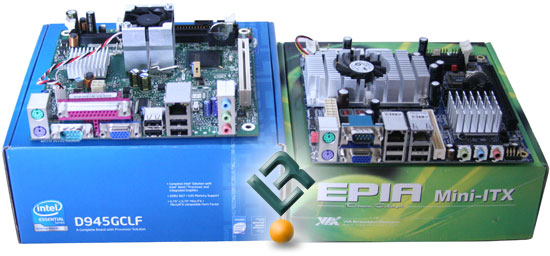Tuesday, July 21, 2009
Monday, June 15, 2009
Intel Atom vs. VIA Nano

Introduction
When we think of the CPU in our systems today, we think of high powered Core 2 processors or a cheaper Phenom in order to power our gaming systems of the day. These two processors are fighting it out for the top of the performance ladder and a battle it has become.
While we concentrate on this sector, the focus is now moving towards the lower end of the spectrum. VIA has really cornered this market in the past when it came to ultra compact PCs; EPIA has been VIA’s biggest success and with the evolution of the VIA processors, each generation has gotten just that little bit more capable. Now Intel has seen just how popular this is, we finally have some competition in this sector.
Until recently the C7 processor defined performance at lower power consumption, but not to be outdone, Intel released at Computex 2008 its introduction to take on VIA; the Atom series processor. However, VIA wasn’t going to let Intel win here, and at the same time announced its latest update to its processor range; the Nano.
Today we will be pitting the Atom platform against the Nano platform. Who has the best performance and energy savings? – Well, we don’t know yet, but by the end of this we will have an informative answer to that. Let’s move on and check out the platforms individually before we get into the testing phase.
Intel ATOM 230 versus VIA Nano L2100 - Battle of the Mini-ITX Platform
Intel ATOM 230 versus VIA Nano L2100 - Battle of the Mini-ITX Platforms
| Manufacturer: | VIA Technologies, Inc. |
| Product: | Intel Atom Versus The VIA Nano |
| Date: | Fri, Aug 01, 2008 - 12:00 AM |
| Written By: | Nathan Kirsch - nate@legitreviews.com |
| Share: | |
The Battle of Mini-ITX Platforms
The Intel Atom and VIA Nano processors have been making a ton of noise in the market place as they are inexpensive, energy efficient and fit into sleek and sexy devices that consumers are looking for today. The day the VIA Nano processor was announced I was actually at Centaur Technologies down in Austin, Texas meeting with Gleen Henry where I got to see some Nano processors being produced right before my eyes. I had to wait nearly a month to get a VIA reference board in my hands with a VIA Nano processor, but it has been worth the wait. Since I have already covered the basics and introduced the Nano processor in my Centaur Technologies Tour article we will jump straight into things.

Armed with the VIA Nano processor and the Intel Atom processor, I can now do a direct performance comparison against two of the most talked about processors for 2008. The VIA Nano reference platform we were sent isn't a retail product, so keep that in mind while reading the rest of the article. The Intel Atom was tested on the D945GCLF, which is a retail product you can purchase today for $66 plus shipping.

These two platforms might both be using Mini-ITX motherboards, but the features do differ between the very different processors. The VIA Nano processor is built using 65nm process technology (the Atom uses 45nm) and it's major claim to fame is the 64-bit Superscalar Speculative Out-Of-Order MicroArchitecture. Will this be enough to keep the Intel Atom processor at bay? Let's take a look a closer look at the test systems and find out which one is faster in the benchmarks!
VIA Nano Processor for Servers: Efficiently Hosting the Cloud
VIA Nano Processor for Mobility
The 64-bit, superscalar VIA Nano processor has been specifically designed to revitalize traditional notebook PC markets, delivering truly optimized performance for the most demanding computing, entertainment and connectivity applications.
A Balanced Mobile Platform From ultra compact UMPCs and tablet form factor designs, to larger, traditional notebook products, the VIA Nano processor strikes the right balance between performance and energy efficiency. Consumers today demand a level of performance comparable to traditional mobile computer designs, without having impact on battery life or size. The VIA Nano processor has what it takes to take mobile computing to the next level; mobility, portability, performance and extended battery life on the road. HD Performance on the Road The VIA Nano processor uses an entirely new floating point architecture that helps provide the smooth delivery of the latest entertainment including the latest HD video codecs, offering superb multimedia performance in compact mobile PC designs with impacting on battery life or portability. Thin and Light Products The VIA Nano processor has the computational smarts to offer full-sized notebook performance without placing restrictions on how thin the device can be. The thermal properties of the VIA Nano processor mean that designing devices that challenge the limitations of the past is easier than ever. | |||
VIA Nano Processor Platform: Key Features64-bit Next Generation Architecture Performance Efficiency Advanced Power and Thermal Management These innovations in processor architecture mean that the VIA Nano processor is able to offer the significant performance improvements that come with the new superscalar architecture within a rigidly low power envelope. High-Performance Floating-Point Execution |
VIA Nano Processor: Re-inventing the Desktop
The 64-bit, superscalar VIA Nano processor is specifically designed to revitalize traditional desktop PC markets, delivering truly optimized performance for the most demanding computing, entertainment and connectivity applications. The VIA Nano processor is ideally suited to this growing PC segment, where low power and performance are paramount in bringing to market products that redefine the desktop PC. Next-Generation Small Form Factor A Greener Desktop PC Delivering the Power of the Cloud | |||
VIA Nano Processor Platform: Key Features64-bit Next Generation Architecture Performance Efficiency High-Performance Computation and Media Processing High-Performance Floating-Point Execution |
VIA Nano™ Processor
The first 64-bit, superscalar processors in VIA's x86 platform portfolio, VIA Nano processors have been specifically designed to revitalize traditional desktop and notebook PC markets, delivering truly optimized performance for the most demanding computing, entertainment and connectivity applications. Building on the market-leading energy efficiency of the VIA C7® processor family, the VIA Nano processor family offers as much as four times the performance within the same power range to extend VIA's performance per watt leadership, while pin compatibility with VIA C7 processors will ensure a smooth transition for OEMs and motherboard vendors, providing them with an easy upgrade path for current system or board designs. The VIA Nano processor family leverages advanced 65 nanometer process technology for the ideal blend of powerful performance and energy efficiency. Underscoring VIA's leadership in processor miniaturization, the VIA Nano processor comes with ultra compact dimensions, enabling a new generation of small form factor designs and new, smaller applications for the x86 platform.
VIA Nano Processor Family
| |||||||||||||||||||||||||||||||||||||||||||||||||||||||||||
Key Architectural Features64-bit Next Generation Architecture High-Performance Computation and Media Processing In particular, the VIA Nano processor places significant emphasis on high-performance floating-point execution, using a completely new algorithm for floating-point adds that results in the lowest floating-point add latency of any x86 processor. Similarly, the floating-point multiplier has the lowest latency of any x86 processor. In practical terms, this means the VIA Nano processor provides exceptionally smooth play back of Blu-ray Disc™ and other HD video formats, which can have encrypted media streams of up to 40Mbps, and low latency rendering of 3D images for an excellent PC gaming experience. The following chart shows the VIA Nano processor's computational benefits over the popular VIA C7 processor:
Advanced Power and Thermal Management
Through the above innovations in processor architecture, the VIA Nano processor is able to offer the significant performance improvements that come with the new superscalar architecture, within the same low power envelope of the VIA C7 processor. Initial production versions of the 1.0 GHz VIA Nano ULV processor will have a maximum Thermal Design Power (TDP) of just 5 watts (and an idle power of just 100mW), scaling up to 25 watts for the 1.8 GHz VIA Nano processor (500mW idle power). An increase in computational performance, coupled with maintenance of the power envelope has naturally resulted in a greatly improved performance per watt. The VIA Nano processor is easily the leading processor in terms of performance per watt on the market.
To find out more about the advanced thermal management of the VIA Nano processor, you can view an architectural overview here. Scalable Upgrade to VIA C7® Processor Greener Technology Enhanced VIA PadLock™ Security Engine
Download the introductory white paper for a more in-depth look at the VIA Nano processor family |
Monday, June 1, 2009
XPS All in one desktops
Cons: The top gets hot the longer it is on but that has not been a big deal. It is very heavy so make sure it is on something stable.
Review: I love this computer! The usb ports are on the side and very easy to get to. I love the wireless keyboard and mouse!
Dell Inspiron 13 Review
Cons: The PC is a very dark blue, almost a black, but that does not bother me (just a heads up). Also, there is only two USB ports and oil will show up slightly on the palm rest.
Review: The oil on the palm rest is easily remedied with a simple cloth. And for ten dollars you can by a USB hub that will allow you to use at least 5 USB ports (These hubs are quite portable now). All in all, this is a great deal.






 Aggressive management of active power includes support for the new "C6" power state, Adaptive PowerSaver™ Technology, new circuit techniques and mechanisms for managing the die temperature, reducing power draw and improving thermal management.
Aggressive management of active power includes support for the new "C6" power state, Adaptive PowerSaver™ Technology, new circuit techniques and mechanisms for managing the die temperature, reducing power draw and improving thermal management.
 The VIA Nano processor continues the VIA processor family's leadership in on-die hardware cryptographic acceleration and security features, and includes dual quantum random number generators, an AES Encryption Engine, NX bit, and SHA-1 and SHA-256 hashing.
The VIA Nano processor continues the VIA processor family's leadership in on-die hardware cryptographic acceleration and security features, and includes dual quantum random number generators, an AES Encryption Engine, NX bit, and SHA-1 and SHA-256 hashing.